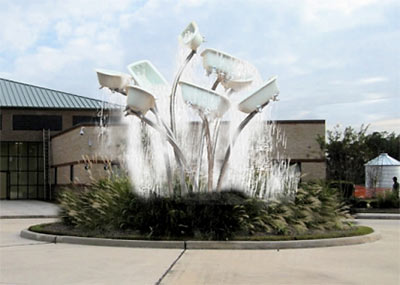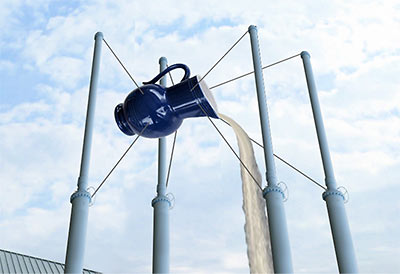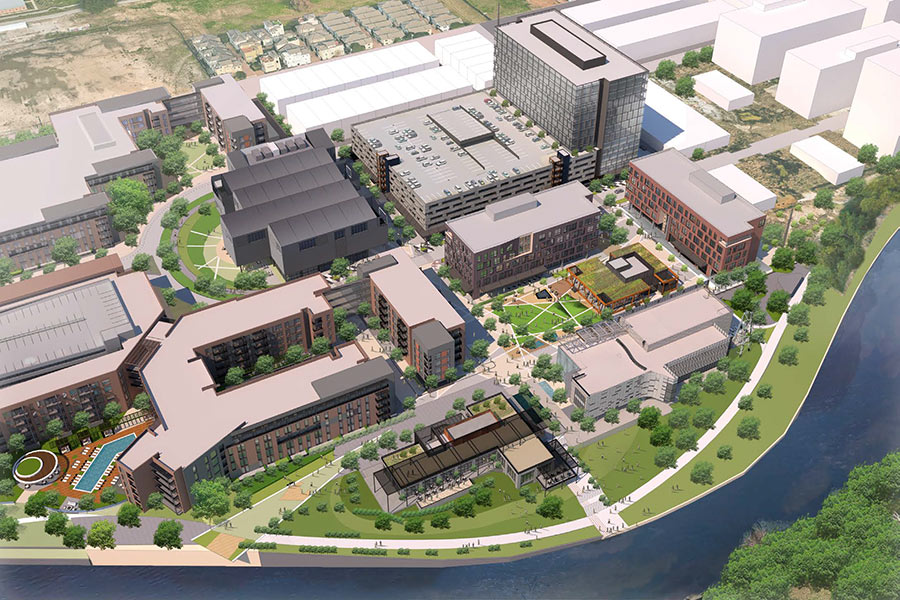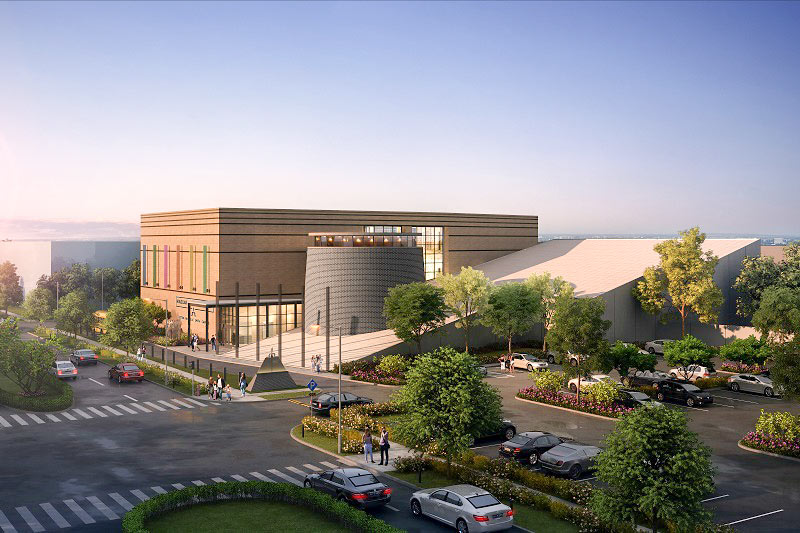
A bouquet of bathtubs by sculptor Donald Lipski will be the centerpiece of a new Houston Water Museum and Education Center in northeast Houston called The WaterWorks. Named “Tubbs” — apparently after Texas country musician and frequent bather Ernest Tubb — Lipski’s sculpture appears to encourage the recycling of water from one bath to the next, although in a playful way perhaps at odds with the standard “short showers only” messages contained in most water-conservation public-information campaigns. The sculpture’s splashing will be controlled, however: That’s a water-recycling system hidden in the bathtub stems.
The museum, scheduled to open in August, will be adjacent to the Northeast Water Purification Plant at the southwest corner of Lake Houston, at 12121 North Sam Houston Parkway East, in Humble.
The bathtub sculpture is a considerable improvement over Lipski’s first proposal for the WaterWorks Museum, the “magic” overflowing water pitcher pictured here:
***

- The WaterWorks: Houston Water Museum + Education Center
- 8 public art projects are set for completion in 2009 [Houston Chronicle]
- What does ‘Tubbs’ say about Houston? Parts 1, 2, and 3 [Arts in Houston]
- Drinking Water Operations [Public Works & Engineering]





With all of the supposed lack of funding available for HPD, HFD, and city services, why are we spending money on this?
kjb434, don’t be such a curmudgeon.
Art and museums are ALSO city services. I know one can make all kinds of redneck snarky comments (“Next time the Katrina people try to break into your house, try calling the Water Museum.”), but you cannot have a one dimensional city and expect people to want to move to or live here. I think this is fun and look forward to seeing it in person.
Too bad the Vallone River Oaks wine porch will not be open, so I could get a glass of red afterward.
The artwork is part of the % for art program:
“The City’s “percent for art ordinance†is municipal policy that identifies a percent of the construction budget developed in the annual Capitol Improvement Plan (CIP), for the aesthetic enhancement of public facilities and civic space and conservation of new and heritage art objects. The ordinance, adopted in 1999, allocates 1.75 percent of certain above ground construction and remodeling costs be set in dedicated coffers for the aesthetic and cultural enhancement of municipal facilities.”
http://www.cachh.org/civic/
UH has been doing this for more than 20 years. There are similar programs all over the country.
Outside of this planned museum, a lot of the art budget will get spent on artworks that adorn sewage and water treatment plants in non-public corridors. So when the operator goes in to check the gauges for the aerobic digester at the sewage treatment plant he/she can look at some art too.
While the ordinance has good intentions, many of times it forces money to be spent on “art” that does not provide any benefit to society. I do agree that the water museum is a slightly better use since the public can enjoy it, but this is one of the rare expenditures that will be publicly accessible.
kjb434, where did your information about your claim that any city-funded art would adorn the interior of buildings inaccessible to the public? If you’ll note the article in Houston Business Journal today, the city art budget is used primarily to decorate such places as airports, parks, rec centers, and other public areas.
http://www.bizjournals.com/houston/stories/2009/01/26/daily52.html
% for art programs are a great idea. In Califiornia I believe its a State requirement, not just for public development but also for larger private developments. It’s true that not all of these projects will be geared towards public viewing. However even in the most remote of locations at least the employees will get to benefit. These are generally relatively small amounts of money and go towards the notion that our infrastructure can be aesthetic as well as just purely functional.
Of course we could always spend that $0.5M adding another dotted line to the Katy Freeway expansion or adding another unit to a strip mall somewhere , something to tell our grandchildren about.
biggerintexas,
It’s because I’ve seen it when touring water and sewage treatment facilities.
The aerobic digester building I spoke about is a place where sewage sludge is broken down and the gases released can be re-used to power the treatment facility. It is a restricted facility because it contain extremely flammable materials. Yet there was artwork in the room. The operator said the department had to spend the money on the artwork and put it somewhere versus spending the money on more infrastructure improvements (which are more valuable).
My issue is, how can you justify this expense when talking to neighborhoods that routinely have flooding, sewage and water problems? We have lots of aging infrastructure that we can easily fund to replace, but this city routinely misspends the money because infrastructure projects aren’t politically sexy. It’s not just the artwork projects, but tons of other mis-allocated funds.
“I know one can make all kinds of redneck snarky comments”
What on earth is “redneck” about prudent fiscal policy that puts adequate police manpower funding above artwork? Some of you people really make some ill-informed comments.
This city has been ignoring infrastructure funding and desperately needed capital improvement projects for years. Like KJB says, it’s just not sexy and so our elected officials continue to ignore it because it doesn’t get them votes. Infrastructure maintenance is always less capital intensive when performed on a “planned” basis, instead of an emergency basis. Unfortunately, this city’s so called leaders seem to only make infrastructure expenditures as an afterthought, instead of a forethought.
Well of course, the operator would know.
kjb434, I think you’re mistaking misuse of money within the sewage/treatment budget and an already allocated fund for use of city art. I completely agree that the city should not use their budget for sewer impovements to decorate the halls of treatment plants. However, the money used for things such as this tub fountain comes from a different place. And, as others point out, art is an important part of a vibrant city.
Read tcpIV’s post?
It’s money being taken out of the CIP. The CIP is what pays for infrastructure improvements such as roads, water lines, water plants, sewage lines, sewage plants, storm sewers.
CK, if you actually READ my post you would realize the “redneck snarky comment” was the one I wrote in parentheses following my statement. I was not referring to fiscal policy.
Some people (you) cannot comprehend my use of humor (however lame) to make a point.
I did read the earlier post. It correctly states that 1.75% of the CIP is dedicated to civic art (such as the tubs). As long as art projects are funded from that allocated amount, I don’t have a problem with it. If the CIP is somehow trasferring money that was allocated for other programs to be used for art, than we certainly have a problem…but I haven’t seen any evidence of that.